By Roger Graham
Director, Growth & Marketing
Hootsuite, Asia Pacific
“Social Media is not only more cost-efficient than advertising, but it also offers great opportunities for innovative engagement with you customers.” — Richard Branson
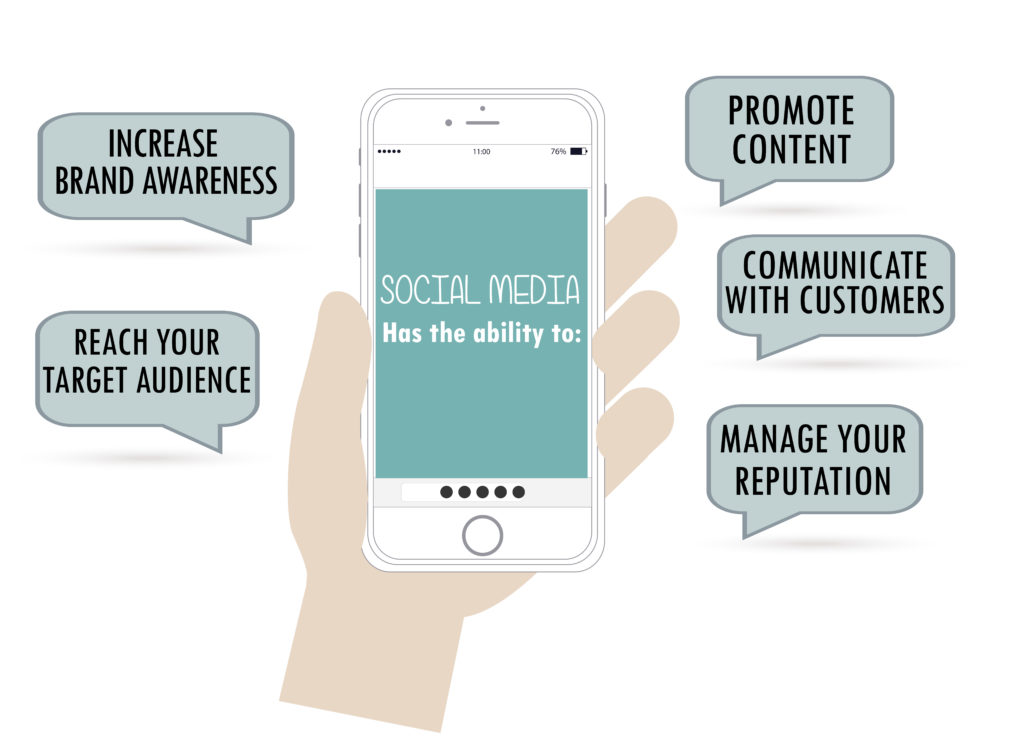
Why Social Media? Why is it Important?
If you take a look at your marketing program, social media can be very cost effective if you know how to run it and dedicate time to it everyday. Marketing really gives you access to what used to be a “word of mouth” kind of environment in traditional media. You’ve got your customer service opportunities, engagement opportunities, and original content. Everyone on earth is in social media, so it’s just a matter of figuring out where you want to target your customers and go after those. It’s a very important part of any marketing mix.
Social is the New Front door
It’s where your customers learn,seek,discover and decide
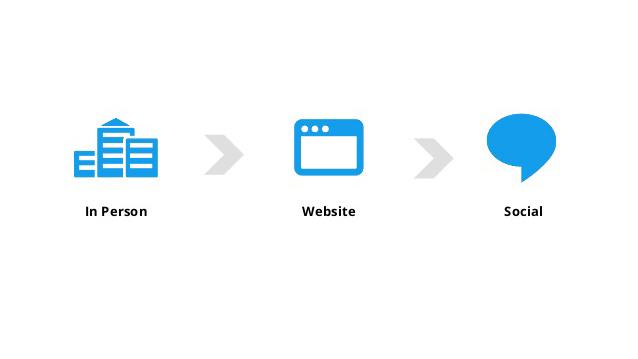
Historically, things have gone from brick and mortar, to an in-person format. That’s the pre-internet era. When the internet came around, websites became the predominant way to deliver a message and more content. Then, when social media started to grow, it became the new front door for people to learn about you brand and your company. Social media is a great platform for people to learn about your business or service without having to visit the physical location of the business.
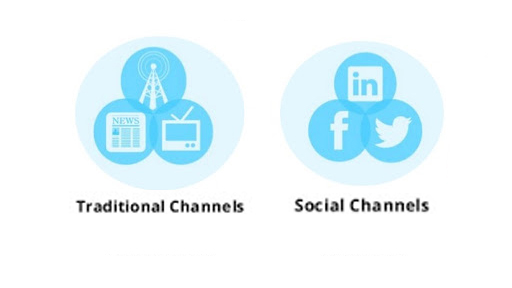
Think Marketing,Think Social Media
Part of the challenge is that the companies are trying to figure out which social networks they should be engaged in, and how much time they need to spend on the different platforms. They also need to know how much ROI they get out of that social media platform.
What is a Social Media Plan
A social media plan outlines your goals, strategies, and action plan to ensure your time has tangible benefits to your brand or business.
It helps you make sure that you understand what the goals are , your strategies, and your action plan to get tangible results. It helps by mapping things out to make sure you understand the things mentioned above. It’ll also help in tracking and measuring the efficiency of the strategies used.
The 4-Step PLan
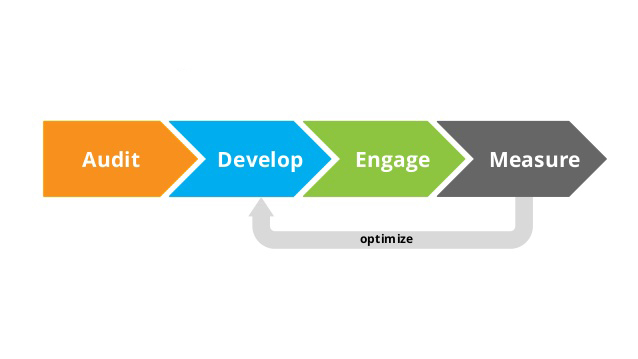
1. Audit
– The first stage is making sure you understand what your current social media environment looks like.
1.1. Assess your social media presence.
1.2. Identify gaps.
1.3. Set profiles.
How to Create a Social Media Audit Template
Step 1. Find all of the social profiles you have and who runs them. Address any content issues.
Create a spreadsheet and write down all the social networks you own and the owner for each.

Step 2. Use Google to find anyone using your brand.
Go on Google and search for any other social media profiles that are representing your company that you don’t own (imposters).
Create a separate spreadsheet.

Step 3. Determine what social networks you want to focus on.
Evaluate the needs for all your social media profiles and create a mission statement for each.
For example: Instagram Profile — To share company culture and company achievements

Align Goal

This is a high-level quick map of your business goals. Translate your business goals into actual social goals.Here’s how you align your goals:
If you wanted to drive Brand Awareness, Reach is something that you should be interested in tracking. It’s making sure you’ve got the social goals around that. For Thought Leadership, you might want to take a look at the comments and inbound links. For Word of Mouth, you might want to take a look at the shares and retweets. For Leads, you’re going to use form fills for the most part. And for Sales, you need to look at the online purchase. And of course, form fills could then lead to online purchases if you have the right nurture flow in place.
Set SMART Goals
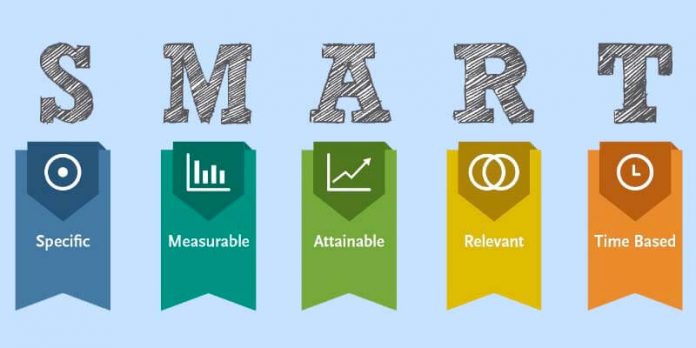
Make sure your goals are SMART: Specific, Measurable, Attainable, Relevant, and Time-Based.
● Avoid goals that only focus on vanity metrics, like Likes and Followers.
● Align goals with department and overall business goals. You need to have a social media discussion with your different departments around how these goals align and fit together. As a social media manager, or the person running the social media accounts of your company, you need to make sure it fits the needs of your different departments. They need to understand what you’re using social media for, because you will be driving sales for the business. You’ll be seeing customer service requests, etc.
Select the right Social Networks
4 key points before selecting your social network profiles:
-
Understand your target audience (age, location, lifestyle). You can appeal more to your audience by understanding these things.
-
Ensure you know how social fits into your marketing program
-
Understand your tone and brand. How you wanted to appear to your audience is important. Brand affinity tends to happen when people can trust a brand and brand trust comes with a bunch of factors.
One of them is your tone being consistent,which means you’re not erratic across the different social media platforms. Carry a brand voice that’s unique and authentic.
Select the Right social Networks
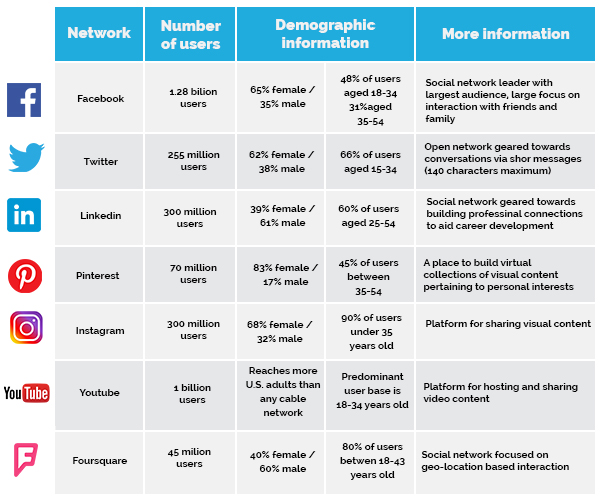
The image above shows a bit of a breakdown. There are some really good research tools out there which you can use. There’s a company called wearesocial.com. They have some really good reports on global metrics and usage of different networks on social media.
Take a look at different social networks and understand which ones are right for you.
Learning from Leaders
● Listen to your followers and industry chatter to get inspiration from industry leaders, competitors, and clients.
● Look back at the best performing content.
● Gain feedback internally from other departments and from customers via a survey.
How to improve your profile?
Every social profile must have the following:
● Bio / Description
-Insert link to website
-Contact Information
● Image
-Profile Picture, Cover Photo
-High resolution
-Maximum fit and dimension
● Insert SEO description of your business profile
Profile Tips and Examples
Virgin
 ● Branded cover image
● Branded cover image
● Link to Bio
● Says what content will be shared
● “Official” account
● Link to main website
Coca-Cola
● Great example of branded lifestyle cover photo tagline
 Herschel Supply
Herschel Supply
 ● Hashtags
● Hashtags
● Strong Imagery – Has a really strong photography presence
● “Official” account
2. Develop
– The second step is developing your plan and understanding what the key components are.
2.1. Set your goals.
2.2. Select social networks.
2.3. Build content plan.
Develop Content Strategy
1. Identify the right content for your brand.
2. Create a content calendar.
3. Publishing content efficiently.
How to decide on what content to post
● What is your brand positioning and tone of voice?
● What issues are important to your brand? Think about other industry issues and topics that are happening. You might want to stay a bit current in the news to understand what’s going on to make sure you can share some important information about the industry or your brands that’ll be relevant to your audience. Make sure you understand what your audience is looking for.
● How do external parties refer to your brand, such as the media, industry experts, etc? Do a bit of research and see what people are saying about your brand and understand whether it’s media industry experts or just reviews from your customers. You might actually find some really interesting nuggets in there that are surprising to you, but will help you know how other people see your brand. Understanding this will help you steer your brand in the direction you’re looking to go, or just continue towards what it’s already known as.
● What is your community interested in when they aren’t talking about your brand or directly to you? Post content around the interests of your audience beyond your specific product. There’s this company named Vega and they have nutritional products like protein powders, bars, etc. One of the things that they do is that they post lifestyle commentary. They do blog posts on “how to stay cool in the summer” or “how yoga really helps the mind and the body.” Even though they’re selling nutritional products, they figured out the lifestyle category that their audience is in so they post content around that.
● Historical performance: What content has worked and what hasn’t?
● Search behavior: What do people search for when they are looking for your brands, products, and services? Take a look at what keyword search is happening in your category, and see what they’re looking for around your brand.
Contents Strategy – Rule of Thirds

Balance Your Message
● Promote your products.
● Share industry/lifestyle news
● Converse with customers.
Creating Content Calendar
● Decide on dates, time, author, audience, and social network
● Develop content topics
● Create “Call-to-action” in post
● Allocate content to different types of posts (example below)
→ 50% of content links back to blog
→ 25% curated from another source
→ 20% drives content related to your business
→ 5% is related to HR and company culture
Theme strategy example: Restaurant

Refer to the image above. We picked a restaurant as an example. Every Monday you can post weekend highlights. The Monday blues happen so they’re interested in what happened on the weekend. Tuesday, you might want to post a life hack tip. Wednesday, a feature of the week. Thursday, a recipe. And Friday, a weekend buzz; what’s happening, what’s going to be exciting during the coming weekend.
There should be a thematic approach to your content that you can perform. You might want to stay regular with your content. You’ll need to have a structure for it. This is just a restaurant example. It doesn’t mean you need to post every single day across all of your social networks. However,it’ll help a lot if you take a look at what the tips are on the frequency of posts depending on the social network that you’re using and what type of content you need to put out there.
Have a structure or template so you don’t have to reinvent the wheel every week or two.
Creating Calendar Content
Here’s an example:
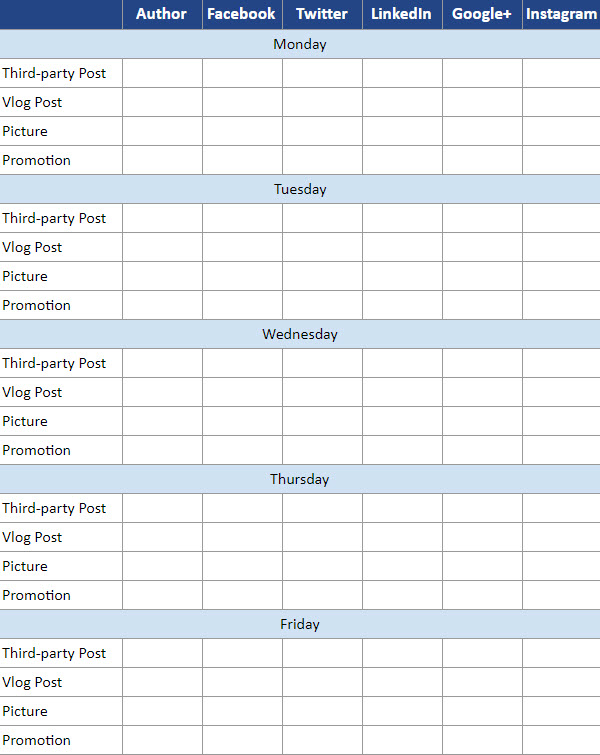
3. Engage
– It’s the green light where you really have to start working with your audience, engaging people, posting content, getting live and active on social media, seeing how things go, and experiencing what’s happening.
3.1. Setup workflow and processes involved.
3.2. Publish and share!
What is Engagement?
It simply means responding to your target market in a way that evokes a response. In social media, it can be a follow, like, or comments.
TIP: Use keywords to listen to the market and offer input, ideas or content.
Publish content efficiently
● Manage all your social content in one place & share with teams
● Schedule your content daily
● Schedule pre-event posts
TIP: Set aside 15-30min a day to find a valuable post or post a valuable content.
Using Facebook effectively
● Use images and video
● Use ads to reach a target audience – ie “lookalike audiences’
● Short text posts – favored by Facebook’s algorithm
● Clear call-to-action (CTA)
TIP: 2 posts per day is optimal for audience engagement.
Please refer to the image below.

Using Twitter
● Keep posts at least 20 characters under the 140 limit to allow for retweets and comments.
● Pictures result in 35% more retweets.
Using Linkedln
● Tagging companies or people that you are connected with adds authority to your posts. Just make sure they are related to the topic!
● Engage your audience by asking relevant questions.
Using Google+
● Sharing “How To” content has shown to perform very well.
● Started using a hashtag for a campaign – keeps everyone turned into campaign.
4. Measure
– You need to be able to measure what’s happening and seeing where the success is and tweak the strategies as you go. As you measure, you’re going to redevelop and change your program to make sure it’s adjusted to fit your business/organization goals. It’ll help a lot if you look at different ways to use analytics to drive traffic.
4.1. Identify metric.
4.2. Use tools to measure progress.
Identify right metrics to measure
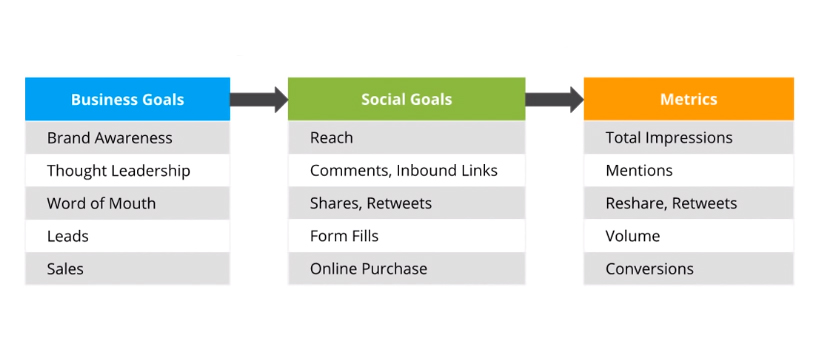
How to Measure?
1. Select social media analytics tools, such as Google Analytics & Hootsuite Analytics. It helps you visualize how things are flowing for you.
2. Use a URL shortener like Ow.ly that can track who is clicking on your content and from what region/geo.
3. Create a custom report and determine how frequently you will review social media metrics (weekly or monthly, for example).
THEN: Optimize your strategy based on the insight you’ve gained from the data you’re tracking.
What to measure?
● Best performing posts
● Engagement
● Traffic
Refine your Strategy
● What worked well and resonates with your audience?
● What didn’t work well?
● What learnings have you taken away?
● How can you refine goals for the next period or quarter?










